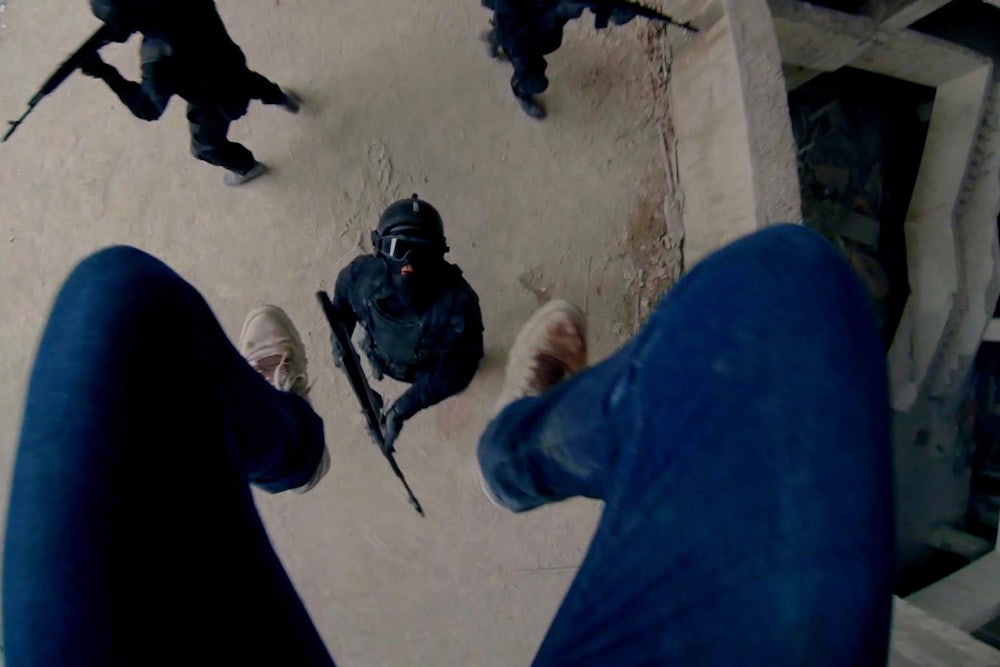The thing I find
strangest about the “immersive” cinematic technique of Hardcore Henry is that, well, it has never struck me as
particularly difficult to become immersed in a movie in the first place. If
anything, movies can be too immersive,
too capable of the illusion that you, the viewer, are taking part in the action
on screen. After Transformers 3, I
was pretty certain I’d been the one punched in the face by a giant robot for
three hours. A gimmick like the one Hardcore
Henry uses—the whole film is told to the camera, first-person-shooter style,
as if we are the protagonist himself—is ultimately more distancing than it is
absorbing. It immediately alerts us to the artifice of the movie. A great movie
fools you into thinking it’s really happening. By trying to make us a part of
the film itself, Hardcore Henry just
keeps reminding us it’s not.
I’m about to give the story more thought and effort than the film does, by attempting to describe it. We are woken up to a beautiful woman (Haley Bennett), who says our name is Henry, we’re a cyborg with human memories, and she’s our wife. She keeps getting kidnapped by some sort of evil mutant named Akan (Danila Kozlovzky), who’s half–Julian Assange, half–Kurt Cobain, with some Crispin Glover mixed in. So we try to save her, while receiving assistance from an avatar named Jimmy (Sharlto Copley), who keeps providing us with guns and mission details, in the movie’s most overt nod to video-game culture. Mostly, though, we just punch and shoot things, pausing from time to time to stab people in the face, jump off of buildings, and stare at an occasional boob. There are moments when you half expect a character to say, “Actually, it’s about ethics in gaming journalism.”
This first-person-shooter cinematic method is not particularly innovative; The Brothers Grimsby just did it a couple of months ago, and this movie doesn’t even have the added bonus of Mark Strong being repeatedly pummeled by an erect elephant penis. The only real creative touch Ilya Naishuller brings to the table is that he never strays from this perspective throughout the entire movie. (We never do find out what Henry looks like, though it did seem strange that his eyes could provide captions at the bottom of his field of vision that translated languages he doesn’t speak.) Niashuller is more caught up in the kineticism of his movie than it’s logic or even perspective: It’s virtually impossible to tell what’s going on during any given fight scene, or where Henry even is. Naishuller just flings the camera all over the place without giving us a sense of what’s happening. The movie often feels like we’re just being thrown down a flight of stairs. I’m old enough to remember when people complained about the shaky-cam in Woody Allen’s Husbands and Wives giving them nausea; much of Hardcore Henry feels like watching what your two-year-old filmed when he got a hold of your iPhone and didn’t realize he’d turned on the camera.
The point of all that shakiness and visual confusion is to simulate reality, but this is not how reality actually works, or even looks. When Henry is asked a question—Henry is unable to talk, to save the film from turning into a chamber drama or something—the camera either moves wildly up and down for yes or wildly left and right for no. But this is not how the human eye works. When you shake or nod your head, your eyes move with you; you remain fixed on what you’re looking at, even if your head is moving. What Henry’s movements evoke isn’t reality, or even video games, which our eyes move with as well; it simply reminds us we’re watching a movie, at least when we’re not trying to keep our stomach from turning over. Hardcore Henry isn’t inventive enough to play with this, to maybe push us to imagine watching ourselves watching a movie. (One can imagine a more daring filmmaker truly working with the parameters of audience manipulation the technique potentially invites, and messing with our heads a bit.) This movie just wants to pull the wings off flies.
It’s tempting to use the oft-cited criticism that “it’s like watching somebody else play a video game,” but Hardcore Henry isn’t even that fun. After all, watching another person play a video game at least lends some individuality to the situation; you see another person, a real live person, react to external stimuli, and you can assess how they handle it. Here, you’re just watching some dude yank a camera around, the reactions as stale and scripted as the stimuli. The whole film feels like a frantic stage play you’re watching from behind glass, a bunch of noise happening somewhere far away from where you’re standing.
You know what Hardcore Henry reminded me of? It reminded me of one of those “stage setters” you see at certain theme parks, where, before you ride a roller coaster, a pre-made video explains to you all sorts of dull narrative details. It’s designed to give you “stakes” before you go on the road, but ends up feeling as urgent and pressing as an animatronic rat at Chuck E. Cheese’s.
Except this is worse, because there’s no actual roller coaster at the end. You just sit in a chair as a two-year-old shakes his iPhone in your face, and every once in a while someone gets their head blown off with a shotgun. Hey, you buy the ticket, you ride the ride.
Grade: D
Looking for more movie recommendations? Check out the latest episode of the Grierson & Leitch podcast.
Grierson & Leitch write about the movies regularly for the New Republic and host a podcast on film, Grierson & Leitch. Follow them on Twitter @griersonleitch or visit their site griersonleitch.com.
